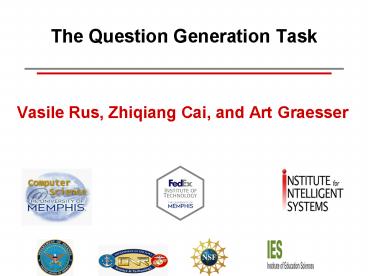The Question Generation Task - PowerPoint PPT Presentation
Title:
The Question Generation Task
Description:
Community wide efforts are needed for building resources, infrastructure ... set of related questions where anaphora and other discourse aspects are present ... – PowerPoint PPT presentation
Number of Views:31
Avg rating:3.0/5.0
Title: The Question Generation Task
1
The Question Generation Task
- Vasile Rus, Zhiqiang Cai, and Art Graesser
2
Outline
- Shared task for NLG?
- Why is question generation important?
- Landscape of example questions
- Definition of Question Generation
- Subtasks
- Evaluation Methodologies
- Black-box vs. Glass-box
- Manual vs. Automatic
- Data sets
3
NLG Shared Task(s) or Not?
- Shared Tasks (3)
- Pros
- Define evaluation metrics
- Compare approaches to the chosen task
- Monitor task
- Community wide efforts are needed for building
resources, infrastructure - Bring the community together
- increase visibility of NLG
- Cons
- Too much effort spent on the chosen task
- Shadow other basic research effort
4
What Shared Task(s)?
- Principle due to the inherent difficulty of
Language Generation choose a (relatively) simple
task - Question Answering has avoided deep questions
- Summarization focuses on extractive summaries
- Textual Entailment text understanding?
- Full-fledged NLU evaluation?
5
Why is Question Generation Important?
- Help systems and FAQ facilities need example
questions for users to model - Information retrieval queries need suggested
revised questions - A need for automated systems with proactive
question asking and answering - Intelligent tutoring systems need automated hints
and other question probes
6
Who may care about Question Generation?
- Natural Language Generation community
- Learning Technologies community
- Intelligent Tutoring Systems
- Subject testing (ETS)
- Question Answering community
7
- Landscape of Questions to Generate
- (Graesser and Person,1994 Lehnert, 1978)
- LEVEL 1 SIMPLE or SHALLOW
- 1. Verification Is X true or false? Did an
event occur? - 2. Disjunctive Is X, Y, or Z the case?
- 3. Concept completion Who? What? When?
Where? - 4. Example What is an example or instance of a
category?). - LEVEL 2 INTERMEDIATE
- 5. Feature specification What qualitative
properties does entity X have? - 6. Quantification What is the
value of a quantitative variable? How much? - 6. Definition questions What does X mean?
- 8. Comparison How is X similar to Y? How is X
different from Y? - LEVEL 3 COMPLEX or DEEP
- 9. Interpretation What
concept/claim can be inferred from a pattern of
data? - 10. Causal antecedent Why did an event occur?
- 11. Causal consequence What are the consequences
of an event or state?
8
Question Generation
- Input one or more sentences
- Output set of questions related to the input
text
9
Examples
- AutoTutor
- INPUT There are no horizontal forces on the
packet after release. - OUTPUT What can you say about the horizontal
forces on the packet? - NIST QA track
- INPUT But here is who will actually direct
Dreamgirls -- none other than Frank Oz, the voice
of Miss Piggy on the Muppets. - OUTPUT Who is the voice of Miss Piggy?
10
Subtasks - Input
- INPUT
- Input one sentence
- Input one paragraph
- Input specified in a formalism appropriate for
Language Generation
11
Subtasks - Output
- OUTPUT
- Subtask 1 generate question containing only
words from input - Subtask 2 generate questions containing only
words from input, except for one word - Subtask 3 generate questions containing replaced
phrases from input - Subtask 4 generate WHO questions, WHEN
questions, etc. - Subtask 5 freely generate questions
12
Evaluation
- Black-box
- Simply look at the quality of the output
- Glass-box
- Some subtask are designed to test for particular
components of language generation - Subtask 1 is suitable for testing syntactic
variability and microplanning - Subtask 2 is suitable for testing lexical
generation
13
Evaluation
- Manual
- Human experts judge the questions on quality
and/or relevance - What is a good question?
- Automatic
- Suitable for some subtasks
- Use automatic evaluation techniques from
summarization (extractive summarization)
14
Evaluation - Metrics
- Precision
- Recall
- Prepare a set of good questions for each input
- Re-use existing data, e.g. NIST QA data
- Use NIST method
- Collect all good questions from all submissions
and use it as the pool of GOLD STANDARD questions - Ranking MRR (mean reciprocal rank)
- Confidence measure confidence weighted measure
15
Data
- AutoTutor
- Hints and prompts to elicit physics principles
- Expert-generated questions in curriculum scripts
- NIST QA track
- Thousands of Question-Answer pairs
- Manipulate existing data
- New data
16
Pros and Cons
- Pros
- Textual input could help with wide adoption
- Suitable for glass- and black-box evaluation
- Automatic evaluation is possible
- Data sets already available or almost available
- Cons
- Discourse planning
- Alternative generate set of related questions
where anaphora and other discourse aspects are
present - Pre-posed context clause
- Fundamental issue
- What is a good question?
17
Summary
- Simple and attractive
- Automatic evaluation possible
- Data sets available
18
Thank You!































